The Commercial Panini Machine Market is estimated to be valued at USD 1100.2 million in 2025 and is projected to reach USD 1897.2 million by 2035, registering a compound annual growth rate (CAGR) of 5.6% over the forecast period.
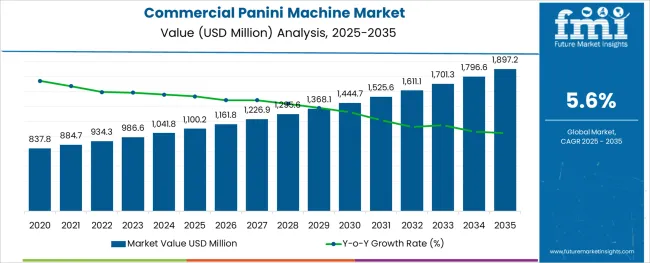
The commercial panini machine market is exhibiting consistent growth, fueled by rising demand for quick service food options, modernization of foodservice establishments, and increasing emphasis on operational efficiency. The adoption of these machines is being supported by evolving consumer preferences toward freshly prepared sandwiches and the need for reliable, high throughput equipment in commercial kitchens.
Foodservice operators are prioritizing appliances that offer speed, consistency, and durability, aligning with the growing pace of service in restaurants and cafes. Future growth is anticipated as technological advancements in heating elements, energy efficiency, and ergonomic designs continue to emerge, meeting both productivity and sustainability goals. Opportunities are also being shaped by the increasing penetration of organized foodservice chains in emerging markets and the drive to enhance kitchen workflows.
market is being further strengthened by product innovations aimed at minimizing downtime and enhancing menu versatility, laying the foundation for continued expansion and differentiation.
The market is segmented by Product Type, Application, and Sales Channel and region. By Product Type, the market is divided into Contact grills, Press grills, and Open grills. In terms of Application, the market is classified into Restaurants, Cafes, and Hotels. Based on Sales Channel, the market is segmented into Offline and Online.
Regionally, the market is classified into North America, Latin America, Western Europe, Eastern Europe, Balkan & Baltic Countries, Russia & Belarus, Central Asia, East Asia, South Asia & Pacific, and the Middle East & Africa.
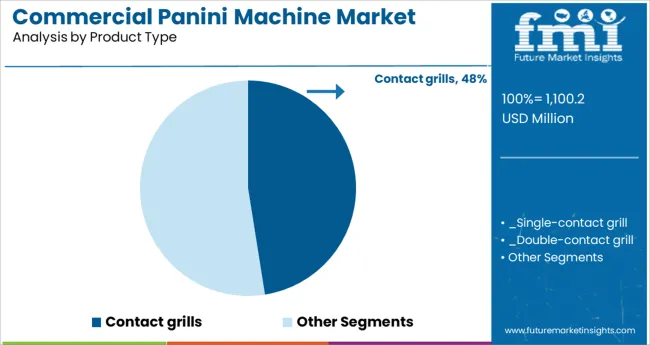
When segmented by product type, contact grills are expected to hold 47.50% of the total market revenue in 2025, positioning them as the leading product type. This leadership is being attributed to their ability to deliver uniform heating, reduced cooking times, and high reliability under continuous commercial use.
The robust construction of contact grills combined with features such as adjustable plates, non-stick surfaces, and precise temperature controls has enabled seamless integration into diverse kitchen environments. Operational efficiency has been enhanced as these machines allow simultaneous grilling on both sides of the product, reducing turnaround time and labor intensity.
Their versatility in preparing a variety of sandwiches and grilled items has further reinforced their widespread adoption across fast-paced commercial settings where speed and consistency are paramount.
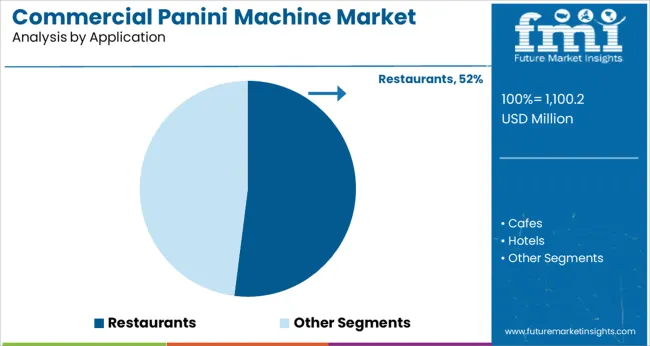
Segmented by application, restaurants are projected to account for 52.00% of the commercial panini machine market revenue in 2025, maintaining their dominant position. This prominence is being driven by the growing emphasis on menu diversification and delivering premium quality sandwiches to meet customer expectations in competitive dining markets.
The adoption of panini machines in restaurants has been supported by their capability to streamline operations during peak hours while maintaining consistent output. Restaurants have increasingly recognized the value of these machines in enhancing customer satisfaction by offering freshly made, customizable options that align with evolving dining preferences.
Additionally, the ability to optimize kitchen space and improve throughput has positioned restaurants as the largest adopters of commercial panini machines, reinforcing their leadership in this segment.
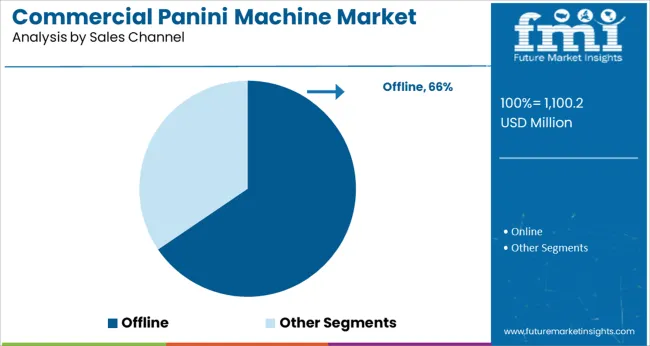
When segmented by sales channel, offline channels are forecast to capture 65.50% of the market revenue in 2025, establishing themselves as the leading distribution route. This dominance is being reinforced by the preference among commercial buyers for direct engagement with suppliers and distributors to evaluate equipment performance and reliability before purchase.
The ability to access product demonstrations, negotiate customized deals, and receive after-sales support has made offline channels the favored choice for procurement. Additionally, offline channels have enabled foodservice operators to build trust with suppliers through personal interactions and to ensure compliance with specific operational requirements.
The accessibility of specialized kitchen equipment showrooms and dealer networks has further strengthened the offline segment’s leadership, as buyers prioritize hands-on assessment and immediate fulfillment of their needs.
Vendors try their best to produce advanced panini machines. There are certain factors that producers try to fulfill in order to prevent negative feedback. The producers have boosted the machines with high-tech options. Changes in consumer behavior along with advanced new kitchen instruments with a lot of features have pushed the vendors to adopt certain qualities.
Speed
Speed is one element that is important for the producing panini. The original feature exists to cook food as quickly as possible. The need for speed is still one of the most important drivers when choosing a panini press, even now when you can use it to get a perfectly cooked steak. So to choose the best panini press, the end users rapid heating time tests, relative maximum temperature tests, and the material used for the cooking plates. This affects the heating pattern closely.
Flexibility
The flexibility while shaping the panini along with producing cheese toasties. With different types of paninis, the sustainable and efficient panini press. The best panini press has a Premium, cutting-edge design and is more flexible because they combine different cooking processes in one appliance. For instance, the modern-day panini press combines a contact plate that applies infrared radiation, and a microwave cooking pattern to cook the panini.
Energy Consumption
The commercial panini maker is expected to have an efficient consumption model. The new panini machine is a high-energy user, linking it directly to the speed. Hence, the efficiency becomes directly proportional to the speed one wants to bake. The machine’s design also affects energy consumption; the small ones consume small units of energy.
Programs
The time-saving design of these panini makers comes with integrated chips that have pre-installed programs such as a timer, automatic switch off and on options along with the alert sounds and blinkers. . The best panini presses have a program for each and every dish and automatically switch off when the dish is ready.
Cleaning
The design of these new panini machines that integrates press configuration, ventilation filters, and cooking surfaces breaks the machines into different components that can be separated and cleaned separately. Otherwise, the panini machine cleaning will be less efficient and the appliance will underperform.
Historically, the Commercial Panini Machine market shows growth with a CAGR of 4.6% (2020 to 2025).
In recent years, the popularity of Panini sandwiches has grown exponentially in the United States. This can be attributed to the rise of casual dining and the trend toward healthy, artisanal foods. As a result, sales of commercial Panini machines have increased significantly.
Looking to the future, it is likely that the popularity of Panini sandwiches will continue to grow. This growth will be driven by continued demand for healthy and convenient foods.
For the Future projection of the commercial panini machine market, the value increased from USD 1100.2 million in 2025 to USD 1,701.2 million in 2035. The CAGR (2025 to 2035) is estimated to be 5.6%.
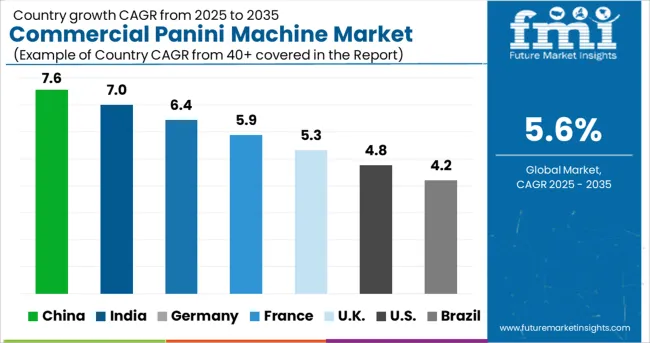
The Asia Pacific region is expected to be the fastest-growing market for commercial Panini machines during the forecast period. The main reason for this growth is the increasing demand for these machines from various end-use industries, such as food service, hospitality, and quick-service restaurants (QSRs).
China is leading the Asia Pacific market by contributing 32% of the total commercial panini machine market share of Asia Pacific.
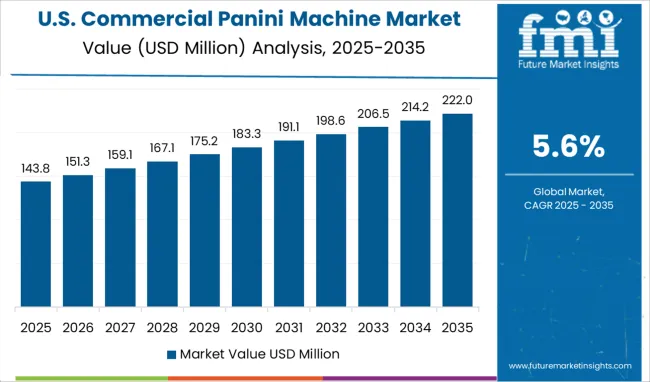
In recent years, the North American commercial Panini machine market has grown rapidly. This is due to the increasing popularity of Panini machines in restaurants and cafes. Commercial Panini machines offer a quick and easy way to make delicious sandwiches. They are also very versatile, allowing for a variety of different sandwich fillings.
The North American commercial Panini machine market is expected to continue growing in the coming years. This is due to the increasing demand from customers for quick and easy sandwich solutions. Additionally, the popularity of Panini machines is expected to continue to grow as they become more widely available.
The USA contributes 68% of total North American revenue for the Commercial Panini Machine Market.
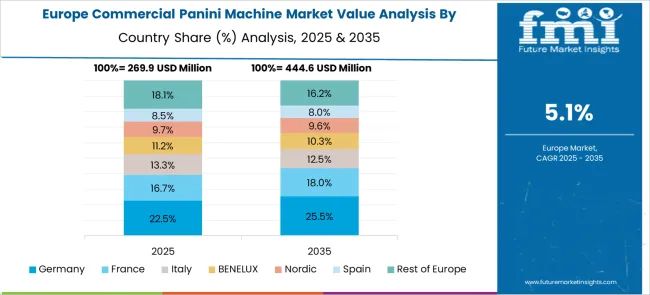
The European commercial Panini machine market is driven by the growing demand for convenient and healthy food options. The growing preference for on-the-go eating is also one of the key factors driving the market growth. Additionally, the increasing number of cafes and restaurants is also fuelling the demand for commercial Panini machines in Europe.
The United Kingdom accumulates 22% of the total European market share for the commercial panini machine market.
The contact grill is made of cast iron The SAVOYE electric grill is used to toast tiny sandwiches like focaccia, buns, blinis, wraps, and Swedish bread. For grilling meats like sliced steaks, this electric contact grill can also be utilized. The PANINI contact grill is used by the best Panini sandwich experts.
While a Panini maker has two cooking plates, top and bottom, an electric griddle just has one. As a result, when using a Panini maker, you don't need to flip your meal because both the top and bottom sides cook simultaneously. Additionally, it implies a shorter cooking time. Therefore, it fuels the overall sales of the commercial panini machines market.
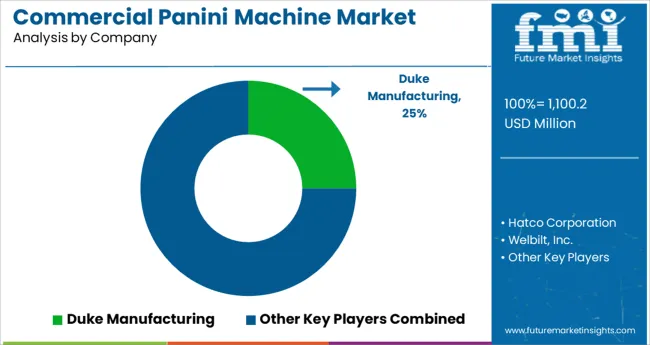
The increasing popularity of panini machines in the food service industry is one of the key factors driving the growth of the market. The growing demand for healthy and nutritious food options is another factor expected to boost the growth of the market. The competitive landscape of the commercial Panini machine market is highly fragmented with many players. Key players in the market include Duke Manufacturing, Hatco Corporation, Welbilt, Inc., and Toastmasters, Inc.
Recent Market Developments
| Attribute | Details |
|---|---|
| Forecast Period | 2025 to 2035 |
| Historical Data Available for | 2020 to 2025 |
| Market Analysis | million for Value and Units for Volume |
| Key Regions Covered | North America; Latin America; Europe; Asia Pacific; Middle East and Africa (MEA); RoW |
| Key Countries Covered | USA, Germany, United Kingdom, France, Spain, Italy, Brazil, Argentina, China, India, Japan, UAE, Australia, New Zealand |
| Key Segments Covered | Product Type, Application, Sales Channel, Geography |
| Key Companies Profiled | Duke Manufacturing; Hatco Corporation; Welbilt, Inc.; Toastmaster, Inc.; Hamilton Beach; Villaware; Lodge; Cuisinart; Cuisinart; Oster; Breville; Warning; De’Longhi |
| Report Coverage | DROT Analysis, Market Forecast, Company Share Analysis, Market Dynamics and Challenges, Competitive Landscape, and Strategic Growth Initiatives |
| Customization & Pricing | Available upon Request |
The global commercial panini machine market is estimated to be valued at USD 1,100.2 million in 2025.
It is projected to reach USD 1,897.2 million by 2035.
The market is expected to grow at a 5.6% CAGR between 2025 and 2035.
The key product types are contact grills, _single-contact grill, _double-contact grill, press grills and open grills.
restaurants segment is expected to dominate with a 52.0% industry share in 2025.
Explore Similar Insights

Thank you!
You will receive an email from our Business Development Manager. Please be sure to check your SPAM/JUNK folder too.
Chat With
MaRIA